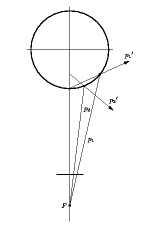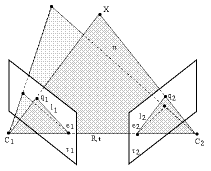Central Panoramic Cameras.
Tomas Svoboda, Tomas
Pajdla, and Vaclav
Hlavac
Keywords: computer vision, omnidirectional vision, epipolar geometry, panoramic cameras, hyperbolic mirror, stereo
Introduction
This page gives the foundations of panoramic stereo vision by
presenting the analysis of epipolar geometry for panoramic
cameras. The panoramic cameras with convex hyperbolic or parabolic
mirror, so called central panoramic cameras, allow the
epipolar geometry as perspective cameras.
Motivation
Using standard perspective (pinhole) cameras the motion estimation
algorithm cannot, in some cases, well distinguish a small pure
translation of the camera from a small rotation. The confusion can be
removed if a camera with large field of view is used. Ideally one
would like to use a panoramic camera which has complete 360°
field of view and sees to all directions. It can be imagined as a
pinhole camera with a spherical imaging surface (instead of planar one
as it is usual) centered at the focal point of the pinhole
camera. Panoramic camera can, in principle, obtain correspondences
from everywhere independently of the direction of motion.
Problems to be solved
Motion estimation from panoramic images requires to:
- design a practical panoramic camera with simple mathematical model
and propose method for its calibration,
- develop the epipolar geometry for panoramic images, and
- work out an algorithm for motion estimation.
Panoramic stereo vision also needs efficient search for the
correspondences in panoramic images which calls for:
- the analysis of the shape of the epipolar curves in order to
constraint the locations of corresponding points and for
- the study of epipolar alignment of the panoramic images in order to speed
up the search.
Design of the mirror
We do not consider here panoramic vision systems with moving parts
since they are not applicable for real time imaging. The panoramic
camera covering almost the whole imaging sphere can be obtained by
combining a classical perspective (pinhole) camera with a convex
mirror.
 |
 |  |
| Spherical mirror. The
reflected optical rays do not
intersect in a unique point. Spherical aberration.
| Hyperbolic mirror. The reflected optical rays intersect
in the focus of the hyperboloid. The center of camera projection coincides with the second mirror focus.
| Parabolic mirror. The reflected optical rays intersect
in the focus of the paraboloid when orthographic projection is
assumed. The second mirror focus goes to the infinity.
|
Next we focus on the case when all reflected rays intersect at a single point. Panoramic cameras which possess this property shall be called central panoramic cameras. Theses cameras allow the epipolar geometry as perspective cameras.
Epipolar Geometry
 Epipolar geometry geometry of two perspective cameras
assigns to each point q1 in one image an
epipolar line l2 in the second image. The
mathematical expression of the epipolar geometry is
Epipolar geometry geometry of two perspective cameras
assigns to each point q1 in one image an
epipolar line l2 in the second image. The
mathematical expression of the epipolar geometry is
q2T Q q1 = 0,
where Q represents 3x3 fundamental matrix. The question arises what is the shape of the epipolar curves for central panoramic cameras.
 Each epipolar plane intersects the mirror in a planar conic. To a
point q1 in the first image a conic in the
second image
Each epipolar plane intersects the mirror in a planar conic. To a
point q1 in the first image a conic in the
second image
q2T A2(E,q1) q2 = 0
is assigned. The matrix
A2(E,q1)
is in general case a nonlinear function of motion parameters
R, t, point
q1, and the calibration parameters of the
panoramic cameras and the mirrors.
 Experiments with real sensor.
Experiments with real sensor.
Back to Omnidir main page.



 Epipolar geometry geometry of two perspective cameras
assigns to each point q1 in one image an
epipolar line l2 in the second image. The
mathematical expression of the epipolar geometry is
Epipolar geometry geometry of two perspective cameras
assigns to each point q1 in one image an
epipolar line l2 in the second image. The
mathematical expression of the epipolar geometry is  Each epipolar plane intersects the mirror in a planar conic. To a
point q1 in the first image a conic in the
second image
Each epipolar plane intersects the mirror in a planar conic. To a
point q1 in the first image a conic in the
second image Experiments with real sensor.
Experiments with real sensor.